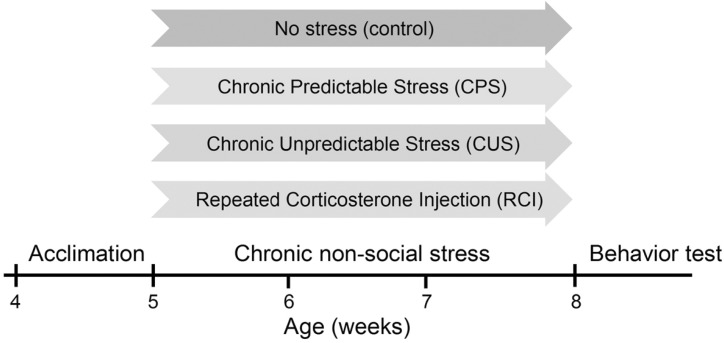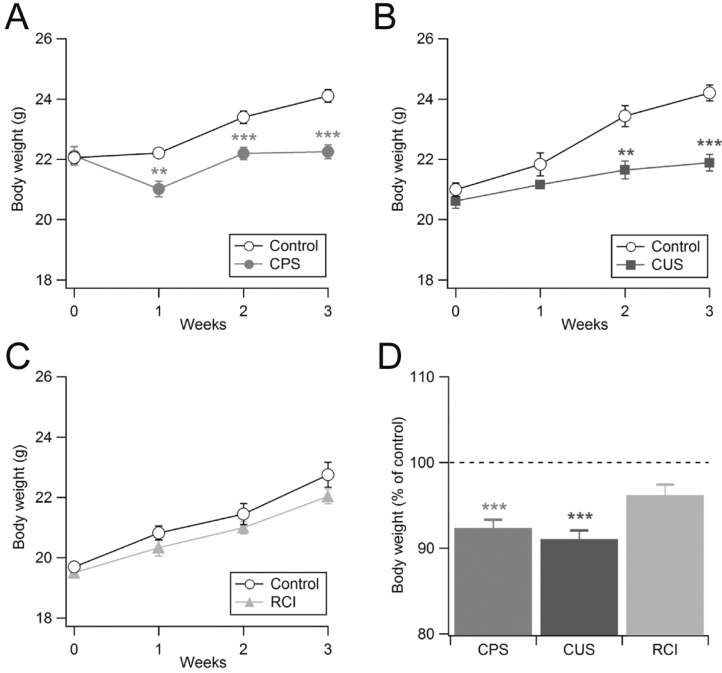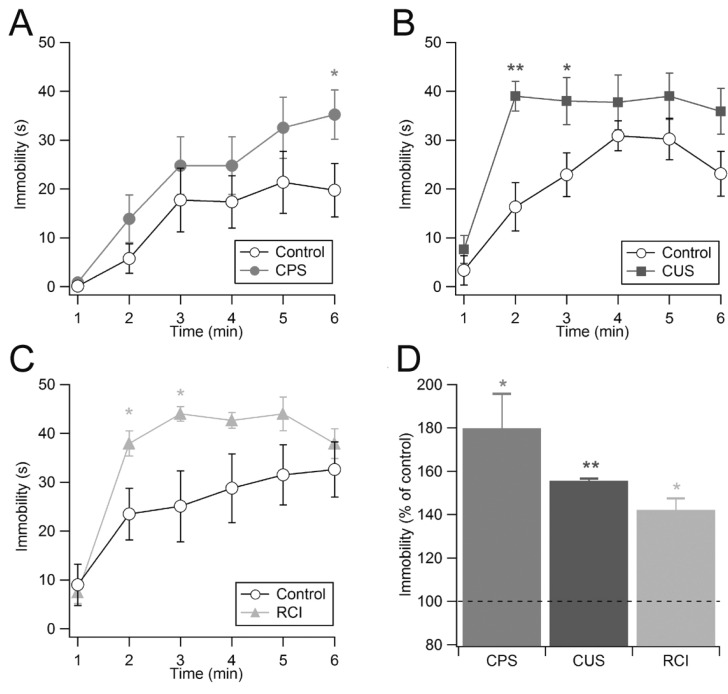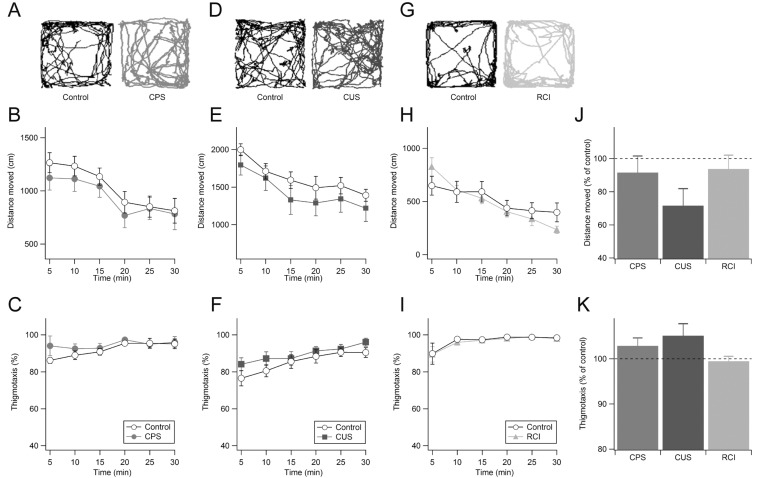Korean J Physiol Pharmacol.
2014 Jun;18(3):263-268. 10.4196/kjpp.2014.18.3.263.
Chronic Non-Social Stress Affects Depressive Behaviors But Not Anxiety in Mice
- Affiliations
-
- 1Department of Physiology, Seoul National University College of Medicine, Seoul 110-799, Korea. kmhwany@snu.ac.kr
- 2Neuroscience Research Institute, Seoul National University Medical Research Center, Seoul 110-799, Korea.
- 3Department of Pharmacology, Seoul National University College of Medicine, Seoul 110-799, Korea.
- 4Seoul National University Bundang Hospital, Seongnam 463-707, Korea.
- KMID: 2285519
- DOI: http://doi.org/10.4196/kjpp.2014.18.3.263
Abstract
- The etiology of most psychiatric disorders is still incompletely understood. However, growing evidence suggests that stress is a potent environmental risk factor for depression and anxiety. In rodents, various stress paradigms have been developed, but psychosocial stress paradigms have received more attention than non-social stress paradigms because psychosocial stress is more prevalent in humans. Interestingly, some recent studies suggest that chronic psychosocial stress and social isolation affects mainly anxiety-related behaviors in mice. However, it is unclear whether chronic non-social stress induces both depression- and anxiety-related phenotypes or induces one specific phenotype in mice. In the present study, we examined the behavioral consequences of three chronic non-social stress paradigms: chronic predictable (restraint) stress (CPS), chronic unpredictable stress (CUS), and repeated corticosterone-HBC complex injection (RCI). Each of the three paradigms induced mild to severe depression/despair-like behaviors in mice and resulted in increased immobility in a tail suspension test. However, anxiety-related phenotypes, thigmotaxis and explorative behaviors, were not changed by the three paradigms. These results suggest that depression- and anxiety-related phenotypes can be dissociated in mouse stress models and that social and non-social stressors might affect brain circuits and behaviors differently.
MeSH Terms
Figure
Cited by 1 articles
-
Alterations of Amino Acid Level in Depressed Rat Brain
Pei Yang, Xuechun Li, Jian Ni, Jingchen Tian, Fu Jing, Changhai Qu, Longfei Lin, Hui Zhang
Korean J Physiol Pharmacol. 2014;18(5):371-376. doi: 10.4196/kjpp.2014.18.5.371.
Reference
-
1. Kessler RC, Bromet EJ. The epidemiology of depression across cultures. Annu Rev Public Health. 2013; 34:119–138. PMID: 23514317.
Article2. Kessler RC, Chiu WT, Demler O, Merikangas KR, Walters EE. Prevalence, severity, and comorbidity of 12-month DSM-IV disorders in the National Comorbidity Survey Replication. Arch Gen Psychiatry. 2005; 62:617–627. PMID: 15939839.
Article3. aan het Rot M, Mathew SJ, Charney DS. Neurobiological mechanisms in major depressive disorder. CMAJ. 2009; 180:305–313. PMID: 19188629.
Article4. Herman JP, Figueiredo H, Mueller NK, Ulrich-Lai Y, Ostrander MM, Choi DC, Cullinan WE. Central mechanisms of stress integration: hierarchical circuitry controlling hypothalamo-pituitary-adrenocortical responsiveness. Front Neuroendocrinol. 2003; 24:151–180. PMID: 14596810.
Article5. López JF, Akil H, Watson SJ. Neural circuits mediating stress. Biol Psychiatry. 1999; 46:1461–1471. PMID: 10599476.
Article6. Krugers HJ, Hoogenraad CC, Groc L. Stress hormones and AMPA receptor trafficking in synaptic plasticity and memory. Nat Rev Neurosci. 2010; 11:675–681. PMID: 20820185.
Article7. McEwen BS. Physiology and neurobiology of stress and adaptation: central role of the brain. Physiol Rev. 2007; 87:873–904. PMID: 17615391.
Article8. Pittenger C, Duman RS. Stress, depression, and neuroplasticity: a convergence of mechanisms. Neuropsychopharmacology. 2008; 33:88–109. PMID: 17851537.
Article9. Bao AM, Meynen G, Swaab DF. The stress system in depression and neurodegeneration: focus on the human hypothalamus. Brain Res Rev. 2008; 57:531–553. PMID: 17524488.
Article10. Mathew SJ, Price RB, Charney DS. Recent advances in the neurobiology of anxiety disorders: implications for novel therapeutics. Am J Med Genet C Semin Med Genet. 2008; 148C:89–98. PMID: 18412102.
Article11. Rygula R, Abumaria N, Flügge G, Fuchs E, Rüther E, Havemann-Reinecke U. Anhedonia and motivational deficits in rats: impact of chronic social stress. Behav Brain Res. 2005; 162:127–134. PMID: 15922073.
Article12. Kinsey SG, Bailey MT, Sheridan JF, Padgett DA, Avitsur R. Repeated social defeat causes increased anxiety-like behavior and alters splenocyte function in C57BL/6 and CD-1 mice. Brain Behav Immun. 2007; 21:458–466. PMID: 17178210.
Article13. Slattery DA, Uschold N, Magoni M, Bär J, Popoli M, Neumann ID, Reber SO. Behavioural consequences of two chronic psychosocial stress paradigms: anxiety without depression. Psychoneuroendocrinology. 2012; 37:702–714. PMID: 21962377.
Article14. Keeney AJ, Hogg S. Behavioural consequences of repeated social defeat in the mouse: preliminary evaluation of a potential animal model of depression. Behav Pharmacol. 1999; 10:753–764. PMID: 10780291.
Article15. Krishnan V, Han MH, Graham DL, Berton O, Renthal W, Russo SJ, Laplant Q, Graham A, Lutter M, Lagace DC, Ghose S, Reister R, Tannous P, Green TA, Neve RL, Chakravarty S, Kumar A, Eisch AJ, Self DW, Lee FS, Tamminga CA, Cooper DC, Gershenfeld HK, Nestler EJ. Molecular adaptations underlying susceptibility and resistance to social defeat in brain reward regions. Cell. 2007; 131:391–404. PMID: 17956738.
Article16. Becker C, Zeau B, Rivat C, Blugeot A, Hamon M, Benoliel JJ. Repeated social defeat-induced depression-like behavioral and biological alterations in rats: involvement of cholecystokinin. Mol Psychiatry. 2008; 13:1079–1092. PMID: 17893702.
Article17. Kwak C, Lee SH, Kaang BK. Social isolation selectively increases anxiety in mice without affecting depression-like behavior. Korean J Physiol Pharmacol. 2009; 13:357–360. PMID: 19915697.
Article18. Marin MT, Cruz FC, Planeta CS. Chronic restraint or variable stresses differently affect the behavior, corticosterone secretion and body weight in rats. Physiol Behav. 2007; 90:29–35. PMID: 17023009.
Article19. Zhao Y1, Ma R, Shen J, Su H, Xing D, Du L. A mouse model of depression induced by repeated corticosterone injections. Eur J Pharmacol. 2008; 581:113–120. PMID: 18184609.
Article20. Ayensu WK, Pucilowski O, Mason GA, Overstreet DH, Rezvani AH, Janowsky DS. Effects of chronic mild stress on serum complement activity, saccharin preference, and corticosterone levels in Flinders lines of rats. Physiol Behav. 1995; 57:165–169. PMID: 7878112.
Article21. Pitman DL, Ottenweller JE, Natelson BH. Plasma corticosterone levels during repeated presentation of two intensities of restraint stress: chronic stress and habituation. Physiol Behav. 1988; 43:47–55. PMID: 3413250.
Article22. Lee B, Sur B, Park J, Kim SH, Kwon S, Yeom M, Shim I, Lee H, Hahm DH. Chronic administration of baicalein decreases depression-like behavior induced by repeated restraint stress in rats. Korean J Physiol Pharmacol. 2013; 17:393–403. PMID: 24227939.
Article23. Harris RB, Zhou J, Youngblood BD, Rybkin II, Smagin GN, Ryan DH. Effect of repeated stress on body weight and body composition of rats fed low- and high-fat diets. Am J Physiol. 1998; 275:R1928–R1938. PMID: 9843882.24. Schweizer MC, Henniger MS, Sillaber I. Chronic mild stress (CMS) in mice: of anhedonia, 'anomalous anxiolysis' and activity. PLoS One. 2009; 4:e4326. PMID: 19177164.
Article25. Gregus A, Wintink AJ, Davis AC, Kalynchuk LE. Effect of repeated corticosterone injections and restraint stress on anxiety and depression-like behavior in male rats. Behav Brain Res. 2005; 156:105–114. PMID: 15474655.
Article26. Lee JK. Anti-depressant like effect of methyl gallate isolated from acer barbinerve in mice. Korean J Physiol Pharmacol. 2013; 17:441–446. PMID: 24227946.27. Steru L, Chermat R, Thierry B, Simon P. The tail suspension test: a new method for screening antidepressants in mice. Psychopharmacology (Berl). 1985; 85:367–370. PMID: 3923523.
Article28. Archer J. Tests for emotionality in rats and mice: a review. Anim Behav. 1973; 21:205–235. PMID: 4578750.
Article29. Prut L, Belzung C. The open field as a paradigm to measure the effects of drugs on anxiety-like behaviors: a review. Eur J Pharmacol. 2003; 463:3–33. PMID: 12600700.
Article30. Simon P, Dupuis R, Costentin J. Thigmotaxis as an index of anxiety in mice. Influence of dopaminergic transmissions. Behav Brain Res. 1994; 61:59–64. PMID: 7913324.
Article31. Lamers F, van Oppen P, Comijs HC, Smit JH, Spinhoven P, van Balkom AJ, Nolen WA, Zitman FG, Beekman AT, Penninx BW. Comorbidity patterns of anxiety and depressive disorders in a large cohort study: the Netherlands Study of Depression and Anxiety (NESDA). J Clin Psychiatry. 2011; 72:341–348. PMID: 21294994.32. Sartorius N, Ustün TB, Lecrubier Y, Wittchen HU. Depression comorbid with anxiety: results from the WHO study on psychological disorders in primary health care. Br J Psychiatry Suppl. 1996; (30):38–43. PMID: 8864147.
Article33. Gorman JM. Comorbid depression and anxiety spectrum disorders. Depress Anxiety. 1996-1997; 4:160–168. PMID: 9166648.
Article34. Hirschfeld RM. The comorbidity of major depression and anxiety disorders: recognition and management in primary care. Prim Care Companion J Clin Psychiatry. 2001; 3:244–254. PMID: 15014592.35. Olfson M, Fireman B, Weissman MM, Leon AC, Sheehan DV, Kathol RG, Hoven C, Farber L. Mental disorders and disability among patients in a primary care group practice. Am J Psychiatry. 1997; 154:1734–1740. PMID: 9396954.
Article36. Russo SJ, Murrough JW, Han MH, Charney DS, Nestler EJ. Neurobiology of resilience. Nat Neurosci. 2012; 15:1475–1484. PMID: 23064380.
Article37. Ressler KJ, Mayberg HS. Targeting abnormal neural circuits in mood and anxiety disorders: from the laboratory to the clinic. Nat Neurosci. 2007; 10:1116–1124. PMID: 17726478.
Article38. Drevets WC. Neuroimaging studies of mood disorders. Biol Psychiatry. 2000; 48:813–829. PMID: 11063977.
Article39. Fuchs E, Flügge G. Chronic social stress: effects on limbic brain structures. Physiol Behav. 2003; 79:417–427. PMID: 12954436.
Article
- Full Text Links
- Actions
-
Cited
- CITED
-
- Close
- Share
- Similar articles
-
- Chronic Antidepressant Treatment in Normal Mice Induces Anxiety and Impairs Stress-coping Ability
- Physical Exercise Counteracts Stress-induced Upregulation of Melanin-concentrating Hormone in the Brain and Stress-induced Persisting Anxiety-like Behaviors
- Dysfunctional Breathing in Anxiety and Depressive Disorder
- Strain Differences in the Chronic Mild Stress Animal Model of Depression and Anxiety in Mice
- Association of Depressive/Anxiety Symptoms with Ego Resilience and Social Conflict/Support in Patients with Diabetes Mellitus





